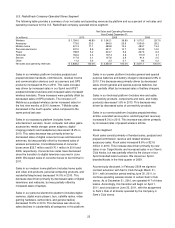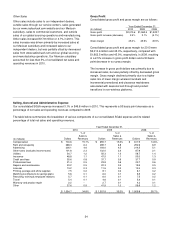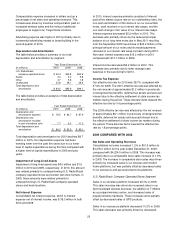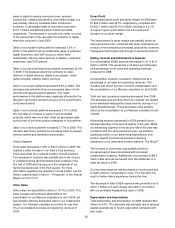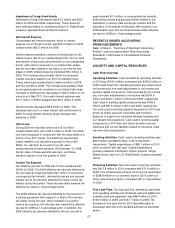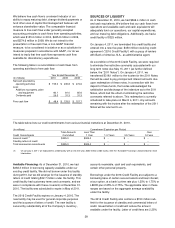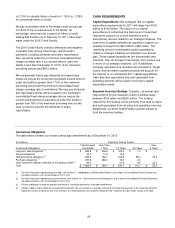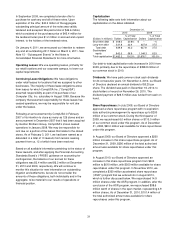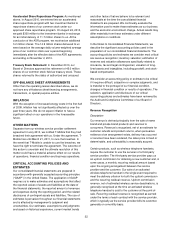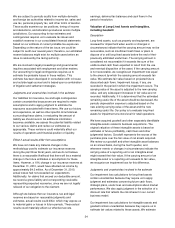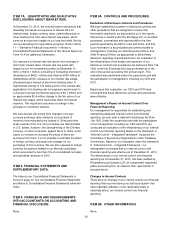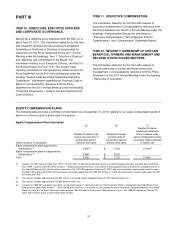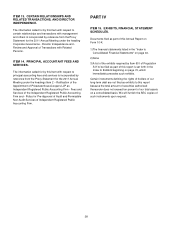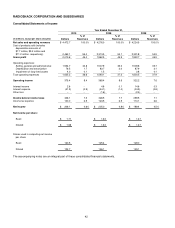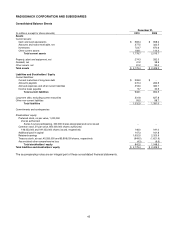Radio Shack 2010 Annual Report Download - page 43
Download and view the complete annual report
Please find page 43 of the 2010 Radio Shack annual report below. You can navigate through the pages in the report by either clicking on the pages listed below, or by using the keyword search tool below to find specific information within the annual report.33
Judgments and uncertainties involved in the estimate
Our revenue recognition accounting methodology requires
us to make certain judgments regarding the estimate of
future sales returns and wireless service deactivations. Our
estimates for product refunds and returns, wireless service
deactivations and commission revenue adjustments are
based on historical information pertaining to these items.
Based on our extensive history in selling activated wireless
telephone handsets, we have been able to establish
reliable estimates for wireless service deactivations.
However, our estimates for wireless service deactivations
can be affected by certain characteristics of and decisions
made by our service providers. These factors include
changes in the quality of their customer service, the quality
and performance of their networks, their rate plan offerings,
their policies regarding extensions of customer credit, and
their wireless telephone handset product offerings. These
factors add uncertainty to our estimates.
Effect if actual results differ from assumptions
We have not made any material changes in the
methodology used to estimate sales returns or wireless
service deactivations during the past three fiscal years. We
continue to update our estimate for wireless service
deactivations to reflect the most recently available
information regarding the characteristics of and decisions
made by our service providers discussed above. If actual
results differ from our estimates due to these or various
other factors, the amount of revenue recorded could be
materially affected. A 10% difference in our reserves for the
estimates noted above would have affected net sales and
operating revenues by approximately $3.3 million in 2010.
Inventory Valuation
Description
Our inventory consists primarily of finished goods available
for sale at our retail locations or within our distribution
centers and is recorded at the lower of average cost (which
approximates FIFO) or market. The cost components
recorded within inventory are the vendor invoice cost and
certain allocated freight, distribution, warehousing and other
costs relating to merchandise acquisition required to bring
the merchandise from the vendor to the location where it is
offered for sale.
Judgments and uncertainties involved in the estimate
Typically, the market value of our inventory is higher than
its aggregate cost. Determination of the market value may
be very complex and, therefore, requires a high degree of
judgment. In order for management to make the
appropriate determination of market value, the following
items are commonly considered: inventory turnover
statistics, current selling prices, seasonality factors,
consumer trends, competitive pricing, performance of
similar products or accessories, planned promotional
incentives, technological obsolescence, and estimated
costs to sell or dispose of merchandise such as sales
commissions.
If the estimated market value, calculated as the amount we
expect to realize, net of estimated selling costs, from the
ultimate sale or disposal of the inventory, is determined to
be less than the recorded cost, we record a provision to
reduce the carrying amount of the inventory item to its net
realizable value.
Effect if actual results differ from assumptions
We have not made any material changes in the
methodology used to establish our inventory valuation or
the related reserves during the past three fiscal years, and
we do not believe there is a reasonable likelihood that there
will be a material change in the future estimates or
assumptions we use to estimate our inventory valuation
reserves. Differences between management estimates and
actual performance and pricing of our merchandise could
result in inventory valuations that differ from the amount
recorded at the financial statement date and could also
cause fluctuations in the amount of recorded cost of
products sold. If our estimates regarding market value are
inaccurate or changes in consumer demand affect certain
products in an unforeseen manner, we may be exposed to
material losses or gains in excess of our established
valuation reserve. We believe that we have sufficient
current and historical knowledge to record reasonable
estimates for our inventory valuation reserves. However, it
is possible that actual results could differ from recorded
reserves.
Estimation of Reserves and Valuation Allowances for
Self-Insurance, Income Taxes, and Litigation
Contingencies
Description
The amount of liability we record for claims related to
insurance, tax and legal contingencies requires us to make
judgments about the amount of expenses that will ultimately
be incurred. We are insured for certain losses related to
workers' compensation, property and other liability claims,
with deductibles up to $1.0 million per occurrence. This
insurance coverage limits our exposure for any catastrophic
claims that result in liability in excess of the deductible. We
also have a self-insured health program administered by a
third-party covering the majority of our employees that
participate in our health insurance programs. We estimate
the amount of our reserves for all insurance programs
discussed above at the end of each reporting period. This
estimate is based on historical claims experience,
demographic factors, severity factors, and other factors we
deem relevant.


